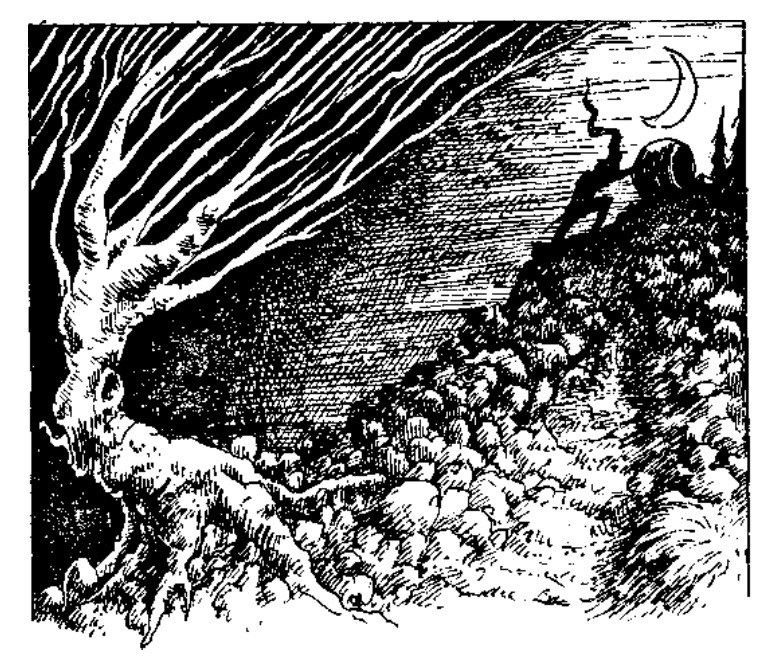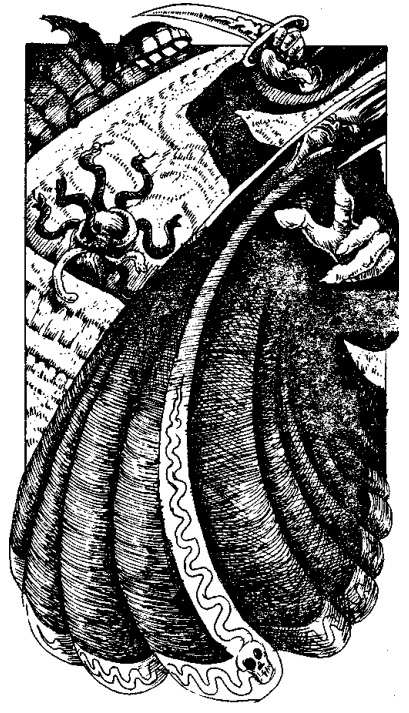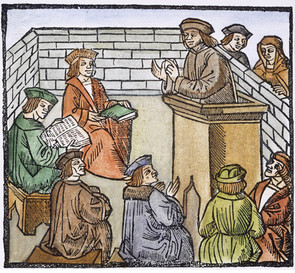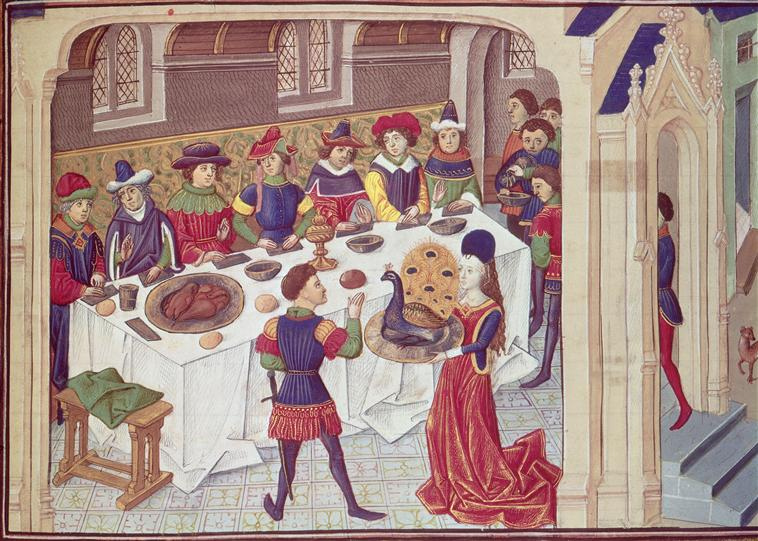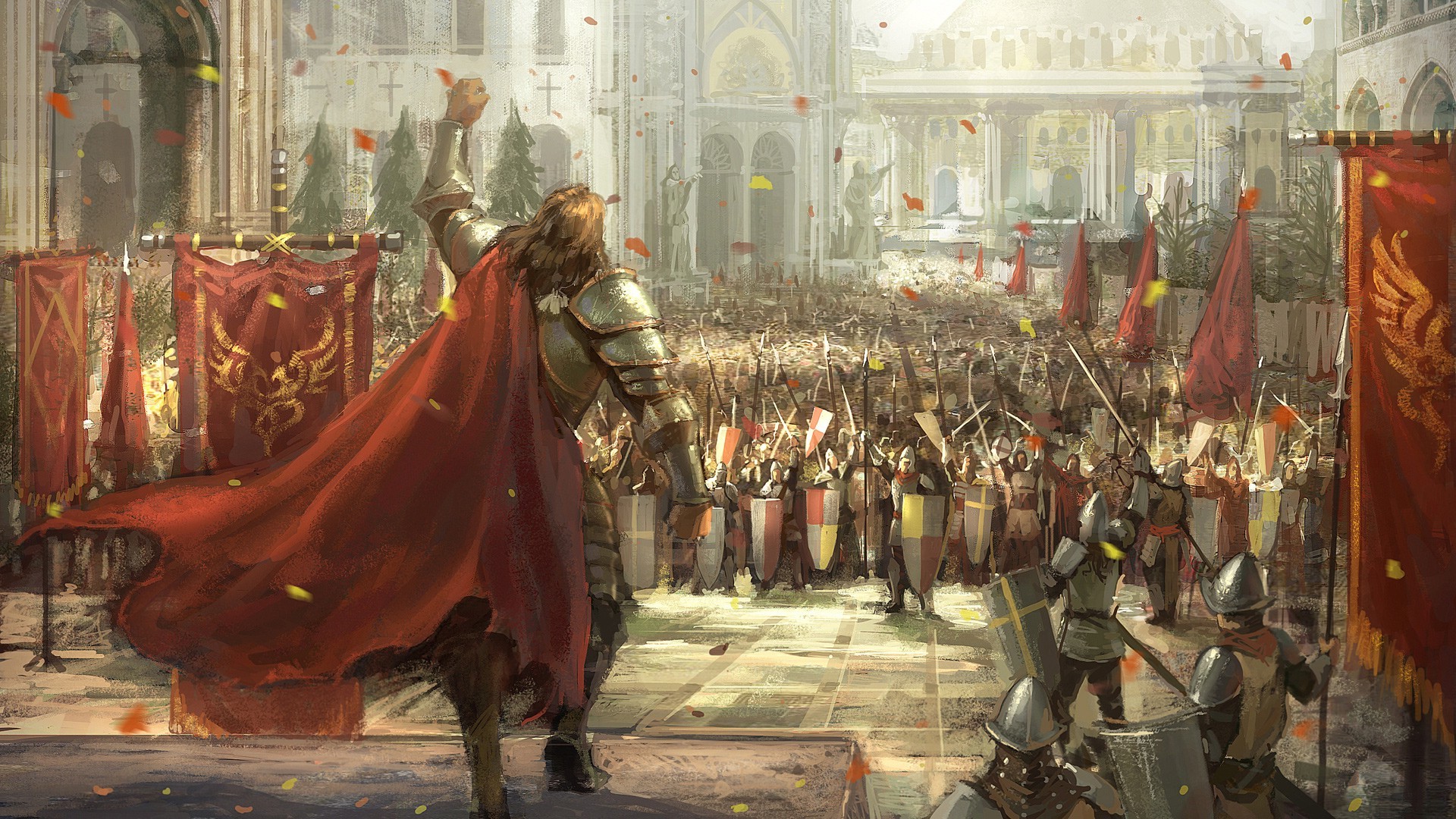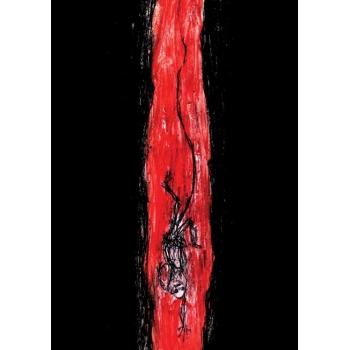 |
| The frog cult grows strong! |
Long-term readers may recall that their last adventure, back in March, saw their final conquest of the Purple Islands and their capture of the snake-man science facility beneath them. Much fucking around with ancient technology ensued. The PCs discovered holographic records describing the fall of the prehistoric snake-man empire. They hatched a bunch of snake-man eggs in incubators, adopted one of the resulting babies, and called it Ambie. They accidentally made contact with the ascended collective consciousness of an alien race out in space somewhere. They discovered space suits which had obviously, and intriguingly, been built for ape-men rather than humans. They successfully restarted an ancient android, interrogated it about its memories, dressed it in purple robes to disguise its inhuman nature, and named it Princess. And, of course, they loaded up on as much captured snake-man wargear as they could carry.
But amidst all this joyful looting, they couldn't escape the knowledge that somewhere, far to the south, the last surviving snake-man scientists were probably rallying the army of demons which would by now have assembled around the crashed fleet beacon whose reactivation had been sensed by their demon buddy Vaul so many months before. So with heavy hearts they entrusted the rulership of the Purple Islands (and the raising of Ambie the Snake-Baby) to their former comrades Erin, Atella, and Zeth, manned and equipped the ship they'd stolen from the Order of the Divine Surgeon, and sailed south.
They landed in Qelong - or my version of it, at any rate - where they swiftly discovered that the local situation was pretty dire. A civil war between rival claimants to the throne had collapsed into something much worse as a plague of madness, curses, and monsters had moved downriver from some unknown source in the southern highlands; and while the rival armies still fought over the coastal regions, upriver the social fabric had disintegrated almost entirely. The cities were crammed with starving refugees from up-country villages, telling confused horror stories about ghosts and monsters and crawling hands. In a gesture that neatly combined mercy with practicality, the PCs selected several of the most capable-looking refugee families and offered them a once-in-a-lifetime opportunity to leave their ravaged homeland and settle as colonists on the Purple Islands, instead!
So as their ship left the harbour, laden with refugees leaving to start a new life on the islands, the PCs paid extortionate prices for horses and then rode upriver, strongly suspecting that the fleet beacon they were looking for had something to do with Qelong's misfortunes. Everywhere they saw the ravages of war, and one night they had a spooky encounter with a herd of seemingly-demonic water buffalo: the last remnant of order seemed to be a riverside town occupied by a company of foreign mercenaries, which they decided to stay as far away from as possible. Beyond this point lay a wilderness of abandoned villages and ruined paddy fields, through which they rode until they came to what had once been a large and prosperous town built around a bridge over the river - but now the bridge was broken, half the town was flooded, and the rest appeared to be uninhabited. As night was coming on, they took shelter from the rain in one of the sturdier-looking buildings on the outskirts of town.
In the middle of the night, Jack was standing watch when he noticed furtive movement in the rain-slicked streets below. He swiftly woke the rest of the party, and Hash's elven night-vision picked out multiple figures stealthily converging on the house from all sides. He called out a challenge, and the figures hid themselves; but soon after a horrible gurgling voice responded from the darkness, calling for them to come down, down to the river's embrace...
In the brief dialogue that followed, it became clear that the beings outside revered some kind of river-monster called 'the naga', and wanted to bring the PCs to meet her. When the PCs politely declined, they became angry, loudly declaring that anyone who did not go willingly would be dragged to the river by force. Minutes later, the creatures attempted to storm the room which the party was in, attacking through every door and window simultaneously - but the PCs were ready for them, and responded with a storm of arrows, laser bolts, and magic missiles that blasted them back out into the night. Only one of the creatures managed to close to melee range, and he had the bad luck to pick Princess for his target, jamming his spear through her robes and getting stunned by an electric shock for his troubles. A further volley of arrows and magic from the PCs soon sent the remaining creatures in the streets outside fleeing back to the safety of the river.
Tying up their captive, the PCs soon discovered that it was some kind of mutant, resembling a drowned man with snake-like fangs and in-growing scales. They attempted to interrogate him, but all he did was rave about the naga in the river; and when the sun rose, they saw him visibly shy away from the light. Advancing cautiously into the town, they discovered that one section of it was still inhabited, with barricades drawn up around a few blocks of houses and exhausted, malnourished guards standing on watch. With the aid of a Comprehend Languages spell, the PCs learned that these ragged survivors were all that remained of the town's population, who now lived in fear of the mutant monsters which crept out to abduct and drown people in the night. Many had tried to leave, but all had been hunted down and drowned - and, horribly, some of them had subsequently reappeared, bloated and mutated, in the ranks of the monsters who now infested the flooded half of the town. They told the PCs that the creatures hated warmth and dryness, and begged them to burn their captive at once - which the party proceeded to do, in order to prove that they weren't in league with the river-monsters. He was very soggy, though, and he didn't burn very well.
The PCs now faced a problem. Comprehend Languages allowed them to understand what the locals were saying, but not to speak to them in turn - so how could they make themselves understood? After some discussion, they hit upon a brilliant idea: and using illusion magic, they projected a silent propaganda video of themselves onto the wall of a nearby house, accompanied by Hogarth's a capella rendition of the theme from Thunderbirds. The awestruck survivors watched as, in the illusion, idealised versions of the PCs stood around in triangle formations, walked away from explosions in slow motion, killed horrible monsters, united beautiful maidens with sexy bad-boy anti-heroes, and generally went through an extremely sanitised version of their actual adventures, all designed to show them as the conquering hero-prophets of their crazy made-up religion. (It had now evolved into a sort-of trinity, with the Bright Lady and the Frog God as rulers of the overworld and underworld, respectively, and the Devourer as an evil devil-figure to which they were both opposed.) When Jack explained, via pantomime, that he and his heroic comrades had now come to liberate the town from the monsters lurking in the floodwater, the desperate villagers eagerly admitted them to their barricade.
But amidst all this joyful looting, they couldn't escape the knowledge that somewhere, far to the south, the last surviving snake-man scientists were probably rallying the army of demons which would by now have assembled around the crashed fleet beacon whose reactivation had been sensed by their demon buddy Vaul so many months before. So with heavy hearts they entrusted the rulership of the Purple Islands (and the raising of Ambie the Snake-Baby) to their former comrades Erin, Atella, and Zeth, manned and equipped the ship they'd stolen from the Order of the Divine Surgeon, and sailed south.
They landed in Qelong - or my version of it, at any rate - where they swiftly discovered that the local situation was pretty dire. A civil war between rival claimants to the throne had collapsed into something much worse as a plague of madness, curses, and monsters had moved downriver from some unknown source in the southern highlands; and while the rival armies still fought over the coastal regions, upriver the social fabric had disintegrated almost entirely. The cities were crammed with starving refugees from up-country villages, telling confused horror stories about ghosts and monsters and crawling hands. In a gesture that neatly combined mercy with practicality, the PCs selected several of the most capable-looking refugee families and offered them a once-in-a-lifetime opportunity to leave their ravaged homeland and settle as colonists on the Purple Islands, instead!
 |
| 'It's OK, guys. You'll love it here!' |
So as their ship left the harbour, laden with refugees leaving to start a new life on the islands, the PCs paid extortionate prices for horses and then rode upriver, strongly suspecting that the fleet beacon they were looking for had something to do with Qelong's misfortunes. Everywhere they saw the ravages of war, and one night they had a spooky encounter with a herd of seemingly-demonic water buffalo: the last remnant of order seemed to be a riverside town occupied by a company of foreign mercenaries, which they decided to stay as far away from as possible. Beyond this point lay a wilderness of abandoned villages and ruined paddy fields, through which they rode until they came to what had once been a large and prosperous town built around a bridge over the river - but now the bridge was broken, half the town was flooded, and the rest appeared to be uninhabited. As night was coming on, they took shelter from the rain in one of the sturdier-looking buildings on the outskirts of town.
In the middle of the night, Jack was standing watch when he noticed furtive movement in the rain-slicked streets below. He swiftly woke the rest of the party, and Hash's elven night-vision picked out multiple figures stealthily converging on the house from all sides. He called out a challenge, and the figures hid themselves; but soon after a horrible gurgling voice responded from the darkness, calling for them to come down, down to the river's embrace...
 |
| Mmm. Watery death. Tempting. |
In the brief dialogue that followed, it became clear that the beings outside revered some kind of river-monster called 'the naga', and wanted to bring the PCs to meet her. When the PCs politely declined, they became angry, loudly declaring that anyone who did not go willingly would be dragged to the river by force. Minutes later, the creatures attempted to storm the room which the party was in, attacking through every door and window simultaneously - but the PCs were ready for them, and responded with a storm of arrows, laser bolts, and magic missiles that blasted them back out into the night. Only one of the creatures managed to close to melee range, and he had the bad luck to pick Princess for his target, jamming his spear through her robes and getting stunned by an electric shock for his troubles. A further volley of arrows and magic from the PCs soon sent the remaining creatures in the streets outside fleeing back to the safety of the river.
Tying up their captive, the PCs soon discovered that it was some kind of mutant, resembling a drowned man with snake-like fangs and in-growing scales. They attempted to interrogate him, but all he did was rave about the naga in the river; and when the sun rose, they saw him visibly shy away from the light. Advancing cautiously into the town, they discovered that one section of it was still inhabited, with barricades drawn up around a few blocks of houses and exhausted, malnourished guards standing on watch. With the aid of a Comprehend Languages spell, the PCs learned that these ragged survivors were all that remained of the town's population, who now lived in fear of the mutant monsters which crept out to abduct and drown people in the night. Many had tried to leave, but all had been hunted down and drowned - and, horribly, some of them had subsequently reappeared, bloated and mutated, in the ranks of the monsters who now infested the flooded half of the town. They told the PCs that the creatures hated warmth and dryness, and begged them to burn their captive at once - which the party proceeded to do, in order to prove that they weren't in league with the river-monsters. He was very soggy, though, and he didn't burn very well.
The PCs now faced a problem. Comprehend Languages allowed them to understand what the locals were saying, but not to speak to them in turn - so how could they make themselves understood? After some discussion, they hit upon a brilliant idea: and using illusion magic, they projected a silent propaganda video of themselves onto the wall of a nearby house, accompanied by Hogarth's a capella rendition of the theme from Thunderbirds. The awestruck survivors watched as, in the illusion, idealised versions of the PCs stood around in triangle formations, walked away from explosions in slow motion, killed horrible monsters, united beautiful maidens with sexy bad-boy anti-heroes, and generally went through an extremely sanitised version of their actual adventures, all designed to show them as the conquering hero-prophets of their crazy made-up religion. (It had now evolved into a sort-of trinity, with the Bright Lady and the Frog God as rulers of the overworld and underworld, respectively, and the Devourer as an evil devil-figure to which they were both opposed.) When Jack explained, via pantomime, that he and his heroic comrades had now come to liberate the town from the monsters lurking in the floodwater, the desperate villagers eagerly admitted them to their barricade.
 |
| BEHOLD YOUR SAVIOURS. |
Within the barricades, things were really wretched: a few hundred survivors eking out a miserable existence on a dwindling stock of rice, and leaving the barricaded area as little as possible. Circe promptly set about winning hearts and minds with the aid of Cure Light Wounds and Purify Food and Water spells, but it was clear that if any fighting was going to happen, the PCs would need to do most of it themselves. They began with information-gathering: Circe went down to the river and caught a fish in a net, only to observe with some disquiet that it was freakishly large and had some kind of weird growth on its side, resembling a cluster of four malformed human faces. Using Speak With Animals she questioned the fish about the naga and its followers, learning that a large 'shoal' of naga-kin mutants was living in the flooded areas of town, and that the naga itself was somehow both present and not present everywhere in the river, a fact which caused the fish no small amount of stress. (At this point Hash had a lightbulb moment: 'The naga's not in the river. The naga is the river!') The fish also told her that all the plant and animal life in the river became increasingly weird and dead the further upriver you went. Experimentally, Circe then used a Bless spell to turn the water around the fish into holy water, and was intrigued by the fact that the horrible four-faced growth on its side promptly tore away from its flank, leaving a bloody patch on its side where it had once been. They then released the fish to seek its fishy destiny elsewhere.
Keen to lure the naga-kin out, the party decided to set a trap for them. Just before dusk, Hogarth took the partially-burned corpse of their deceased captive, cast Control Corpse on it, and instructed it to lie still until someone other than him tried to touch it, and then to grab that person and bring them to the party; he then tied a rope to it and floated it out into the middle of the river, while the party lay in wait, concealed in the ruins at the river's edge. A couple of hours after dark, Hash's darkvision picked out a few naga-kin swimming cautiously towards the corpse, sawing through the rope which bound it, letting it drift a short way downriver, and then swimming carefully over to retrieve it... at which point it promptly grabbed its would-be collector, and Hash cast Light on it, allowing everyone else to see the naga-kin as they recoiled from the glare. As the brightly-glowing zombie grappled with the naga-kin Hogarth cast Choke to subdue its victim further, while the rest of the party tried to keep the others from aiding their comrade with a hail of arrows fired from cover. The naga-kin fled with horrible gurgling wails, but soon returned with more of their kind, who swam rapidly across the river towards the PCs; the party responded by fleeing back towards the barricades, throwing stolen snake-man poison gas grenades behind them to cover their retreat. Circe was jumped by one of them while stumbling in the ruins, but she promptly stabbed a sword through its leg and dragged it off with her as a prisoner while Hash provided covering fire.
As the still-glowing zombie stumbled out of the river carrying the limp body of its captive in its arms, the other naga-kin swiftly surrounded it, eager to destroy it but fearful of its brightness. Casting Invisibility on himself, Hogarth crept over to his zombie servant, and slipped into its pocket a clay pot of the potent acidic venom which the PCs had gathered from the crashed spaceship they found on the Purple Islands. He then whispered one final order: wait until they close in on you, then break the pot. He slipped away as the naga-kin circled the glowing zombie, tearing at its legs with their barbed spears; and as it feel to the ground and they advanced to maim it further, it followed his instructions and smashed the pot. The resulting burst of fiercely-acidic venomous gas and liquid killed several of them in seconds, with the few survivors fleeing, howling, back to the safety of the river.
 |
| Eat space acid, mutant scum! |
No sooner had the PCs started to congratulate themselves on a job well done than they heard something: the terrible, sonorous tolling of a huge bell in the darkness, somewhere on the far side of the river. Soon it was joined by the booming of gongs, and the clashing of cymbals - and then by what sounded like hundreds of horrible gurgling voices, raised in wordless war-cries. Realising that they might have just provoked a full-scale invasion, the PCs grabbed lanterns from the villagers, leaped onto their horses, and rode as quickly as possible down towards the river-bank, looking for all the world like the heroic versions of themselves in their own propaganda video. The water was alive with naga-kin, swarming towards them in waves - so, inspired by Hogarth's recent successes with chemical warfare, the PCs began lobbing pot after pot of salvaged space-acid into the river. The effect was dramatic: as the river turned to poison, inflicting awful chemical burns on the naga-kin swimming through it, their morale broke and they turned and fled back towards their flooded ruins, giving the PCs an opportunity to lob yet more space-acid into them for good measure as they retreated back across the river.
(I made a morale roll and it came up double-6, so I assumed they just routed en masse when the river started turning to poison acid all around them...)
No further attacks came that night, and morning revealed a morbid sight: dozens of acid-burned naga-kin corpses strewn on both sides of the river, along with quantities of dead fish. Rallying the villagers, the PCs indicated that the time had come for them to crush the naga-kin once and for all, and marched them out onto the broken bridge: Circe proceeded to show off by using Warp Wood to make it mend itself right in front of her, allowing them to process onto the far bank, a feat of miracle-working which inspired even more wonder among the already awe-struck survivors. Having located the flooded ruins of a temple as the likely site of the bell they heard during the night, the PCs set the villagers to work collapsing the water-rotted buildings in a wide circle around it, with the aim of turning it into a lake which they could then consecrate and/or poison; but their efforts were hampered by hit-and-run attacks by naga-kin lurking in the nearby buildings, and by the day's end their planned barrier was only half-finished, with nine unfortunate villagers having paid for their progress with their lives. Unwilling to let the naga-kin simply pull down in the night the wall that they had constructed at such cost during the day, the PCs told the villagers to return to their homes as darkness fell, while they themselves climbed up on top of their improvised wall and prepared to defend it against whatever issued forth from the flooded temple after dusk...
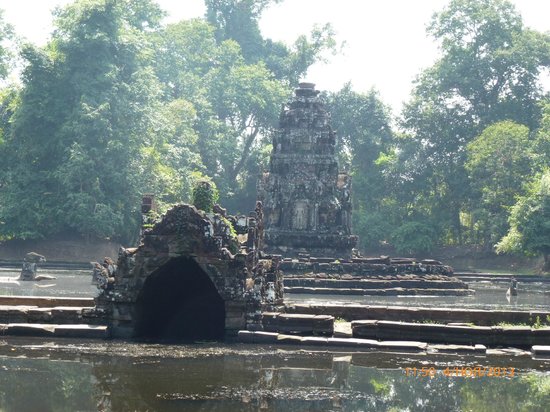

Who will prevail? What new propaganda reels will the PCs one day make based on the events of the night to come, and just how many embarrassing incidents will have to be left out of them when they do? Find out in the next thrilling installment of The Adventures of Team Tsathogga!
